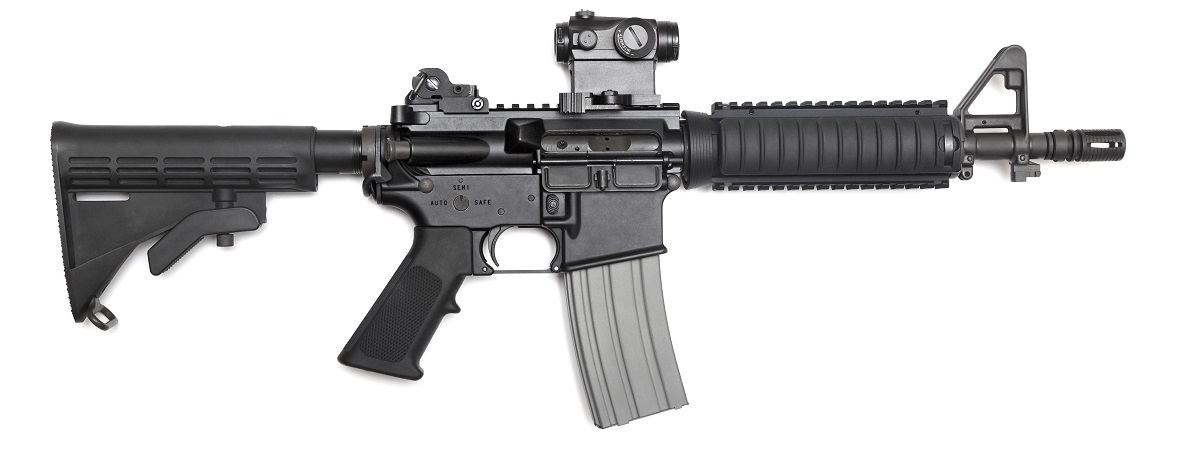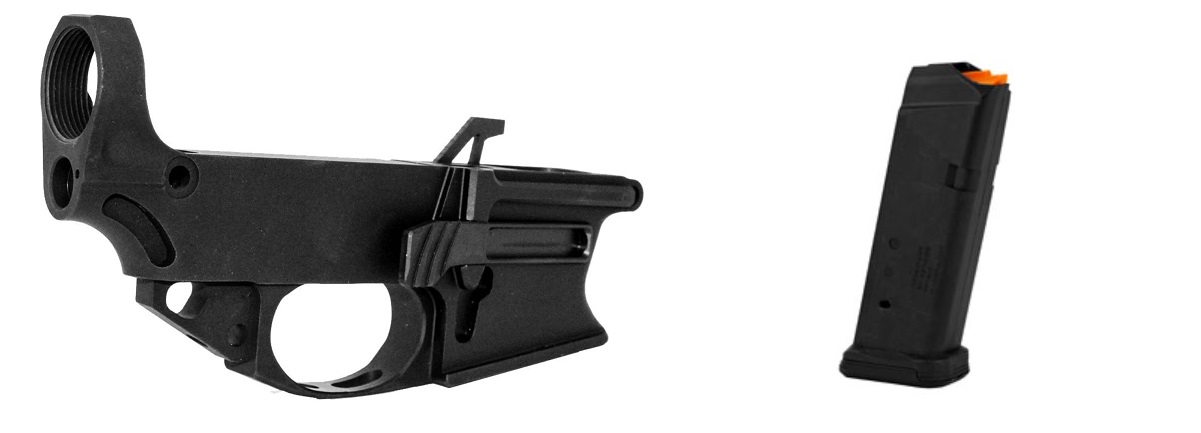How to Build a 9mm AR: The Original AR9 Pistol Guide
Posted by Gunbuilders.com on Feb 29th 2024
This is the original AR9 build guide, brought to you buy the folks who build what we sell. We're covering optimal barrel lengths for accurately sending 9mm through the AR platform, what parts you'll need to assemble a 9mm rifle or pistol, and what components make the 9mm AR's upper and lower receivers tick. Let's begin.
What is an AR9?
The AR9 is the better alternative to modifying an existing AR-15 to fire 9mm. In other words, it's a dedicated 9mm AR platform that ditches the conversion blocks and barrel swaps for a purpose-built upper and lower receiver that uses GLOCK magazines, a modified bolt, and no gas system.
Are all AR9s pistols?

No. Although 9mm is mostly chambered in handguns, the AR9 can take advantage of the fact that, with a rifle-length barrel, the round gains more velocity and accuracy. The AR9 pictured above is using a 16"-barreled upper to provide maximum effective range. We'll look at velocity and ballistics later.
What's the difference between the AR9 and AR-15?

There are some advantages to building a dedicated AR9. Let's review the differences between it, and a standard AR-15 chambered in 5.56, .223, and other centerfire rifle cartridges.
The AR-15 uses Direct-Impingement Gas to Operate
One drawback of the AR-15 is its direct-impingement gas operation: When fired, a port in the barrel redirects gas created by the ignition of the cartridge back to the bolt carrier group. This gas is carried by a gas port and tube. There is no piston capturing this gas. Instead, the gas flows directly into the bolt carrier group, which harnesses that energy via a gas key to drive itself rearward. This cycles the weapon.
This method of cycling causes carbon fouling and debris to quickly accumulate inside the bolt, upper receiver, and barrel extension. Thorough cleaning is required -- usually after every live fire session -- to prevent corrosion and binding of the bolt.
Excess carbon build-up can cause the AR-15 to function less reliability. A fouled bolt may only partially drive rearward. This can cause jams, failures to eject, and failures to feed. The bolt may also fail to fully close, preventing the firing pin from contacting the primer of the round in the chamber.
This is why the AR-15 has a forward assist. The assist may be required to force the bolt closed when carbon has built up inside the barrel extension, and around the bolt carrier.
The 9mm Uses Blowback to Operate
The AR9 doesn't suffer these drawbacks. The powder in the 9mm cartridge ignites rapidly, producing a sudden burst of peak pressure at the bolt face. This energy is enough to force the bolt rearward. No port nor redirected gas is required to cycle the weapon.
That means no carbon fouling is sent into the bolt, upper receiver, nor barrel extension.
How to Build an AR9

The barrel is the most important component of the AR9. It's what you should pick before selecting other parts. The 9mm cartridge can be used for various purposes, which dictates the barrel length you choose for your 9mm AR.
Are you building a highly compact self-defense gun? Do you want to maximize accuracy for long-distance shooting? Are you interested in suppressed fire? Or do you want supersonic velocity for better range?
Subsonic AR9: Pick a 5" Barrel
Most 9mm rounds will stay subsonic (slower than 1,125 feet per second) with a 5" barrel. This will allows for effective suppression with a silencer. With a barrel longer than 5", it's easy to push most 9mm rounds to supersonic velocities, which significantly reduces your suppressor's ability to reduce sound.
With a barrel this short, your AR9 will remain compact, lightweight, and highly maneuverable, while retaining high muzzle velocity just below supersonic speeds. That makes this barrel length an ideal choice for building a home-defense AR9 that provides good power and accuracy in a small package.
Compact AR9: Pick a 7" Barrel
The 7" barrel improves accuracy over a 5" barrel while remaining compact and maneuverable. Many 9mm rounds even obtain optimal velocity with a 7" barrel. That means increasing barrel length any further will provide only marginal gains in velocity.
This is particularly true for lighter rounds that weigh between 90 and 115 grains. At this barrel length, all common 9mm rounds also obtain supersonic velocities at the muzzle, further improving accuracy.
Long-Range AR9: Pick a 16" Barrel
The heaviest 9mm rounds still benefit from a barrel as long as 16", especially if you're chambering 147-grain loads, or +P and +P+ loads. Beyond 16", only marginal gains are acquired, so there's no practical reason to invest in a barrel longer than 16".
This is convenient for the AR9, as this is the minimum legal length required to install a buttstock on your AR9, configuring it as a highly accurate rifle instead of a pistol. With a barrel this long, you'll easily ring steel targets at 200 yards or further.
The Best AR9 Twist Rate is Always 1:10
No matter the barrel you choose for your 9mm AR, it will always perform best with a 1:10 twist rate. This is universally accepted as the ideal twist rate for all 9mm rounds, regardless of grain weight or powder.
The Best AR9 Buffer is 6.5 Ounces

The 9mm cartridge produces a notably higher recoil impulse than other cartridges chambered in the AR platform. That means investing in a heavier buffer: 6.5 ounces is the ideal buffer weight for any AR9 build.
"Can I use an AR15 buffer in my AR9?"
No. Even if you have a heavy-weight AR-15 buffer, the length of the buffer is likely incompatible with the AR9's shorter, one-piece bolt. You must invest in a by-design AR9 buffer.
"Does the AR9 use a special buffer tube?"
No. Although it requires a longer buffer, the AR9 still relies on a standard-length AR-15 buffer tube and recoil spring. There are 9mm-specific buffer tubes that provide a reduced overall length. These units typically come with proprietary buffers and recoil springs.
Picking an AR9 Lower Receiver

The AR9 lower receiver you choose largely depends on what type of magazines you want to use. Old 9mm AR builds used Colt 9mm magazines. But today, virtually all AR9 receivers and bolts are designed to work with standard 9mm GLOCK magazines.
"Do I need a special upper receiver for my AR9?"
No. The AR9 uses a standard AR-15 upper receiver. You can buy a "slick-side" upper receiver that with no forward assist, as the AR9 bolt cannot make use of the forward assist. As mentioned earlier, you will not install a gas tube nor gas block on your 9mm AR.
"What about a handguard?"
The AR9 uses standard AR-15 handguards.
"What lower parts kit do I need for my AR9?"
The AR9 lower receiver relies on the AR-15 lower parts kit. Some components -- like the AR-15 magazine catch -- will not be installed, as the 9mm lower receiver uses a proprietary magazine catch designed to work with GLOCK magazines.
All other internal components normally found in the AR-15 -- including the trigger, hammer, safety, disconnector, springs, pins, and detents -- are still installed when building the AR9.
To save money, grab a 9mm-specific AR-15 lower parts kit that does not come with unnecessary components.
"Can I just install an AR9 upper on my AR-15?"

Although an AR9 upper will fit an AR-15 lower receiver, converting your AR-15 to chamber 9mm rounds is not ideal. You will first need to modify the lower receiver by installing a 9mm conversion block. If the AR-15 you're converting was originally configured as a rifle, you must also install a 16" 9mm upper.
Installing a pistol-length 9mm upper atop an AR-15 lower receiver that was configured as a rifle is, according to the ATF, no different that building a short-barreled rifle -- even if you remove the buttstock and run the weapon with a pistol brace or naked buffer tube.
Conversion blocks are inherently unreliable, too. They include a 9mm ejector made to work with the AR9's bolt. But the conversion block often fails to install correctly, and any poor fitment of the block will cause the ejector to fail to function properly, resulting in jams and failures to eject spent casings.
It is simply better to build an AR9 using a dedicated 9mm lower receiver.
DISCLAIMER: If you are new to the world of DIY gun building, you likely have a lot of questions and rightfully so. It’s an area that has a lot of questions that, without the correct answers, could have some serious implications. At GunBuilders.com, we are by no means providing this content on our website to serve as legal advice or legal counsel. We encourage each and every builder to perform their own research around their respective State laws as well as educating themselves on the Federal laws. When performing your own research, please be sure that you are getting your information from a reliable source.

